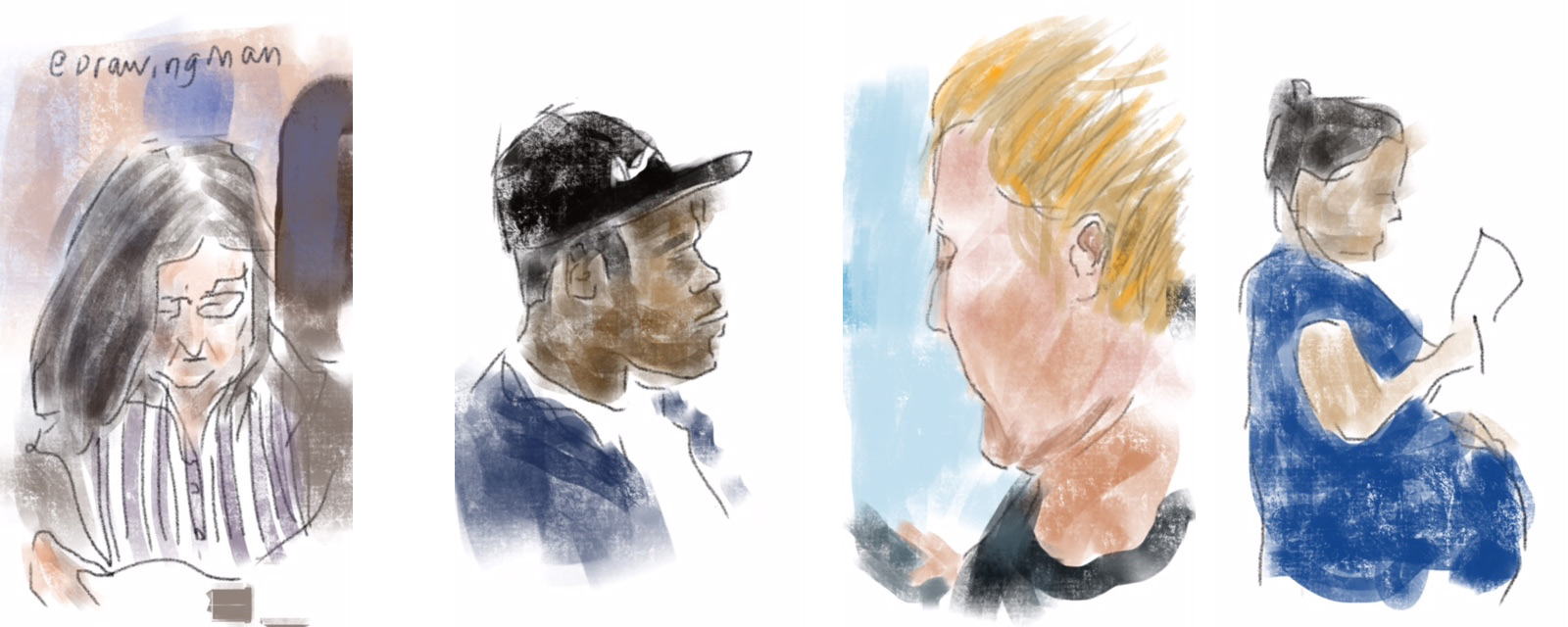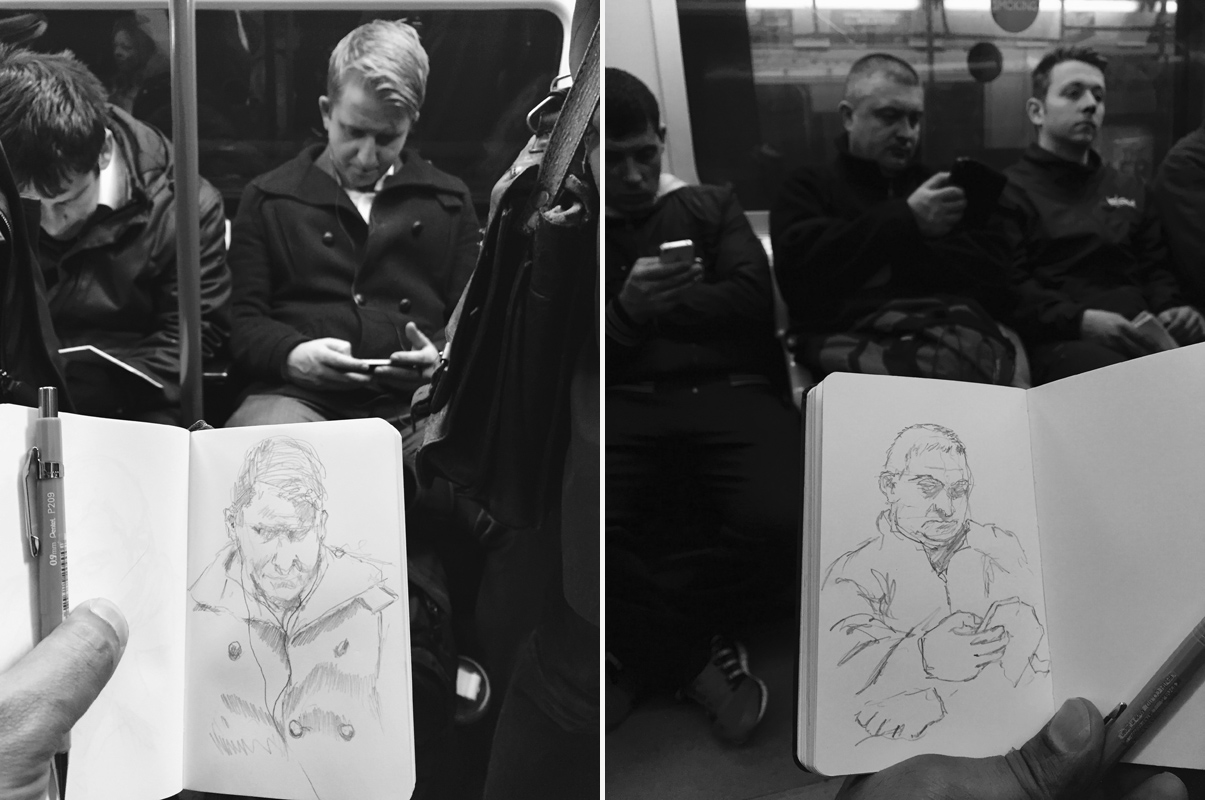Interview: Artist Narinder Sagoo
An architect at Foster + Partners by day captures human moments on his morning commute

Narinder Sagoo has worked at Foster + Partners for 20 years as an architectural illustrator. His hand drawing skills are incredible—he renders rich, precise scenes that bear emotion and story all without backtracking, erasing or changing course. Even more remarkable, the order in which he draws these scenes is part of the story telling itself. Watching him work is mesmerizing. Sagoo recently switched from drawing with paper and pencil to using the iPad Pro and his software of choice lets him play back every stroke in an animation that has become as important to his work at the final drawing. We recently met Sagoo and after talking for a while about his work he casually mentioned that he likes to draw portraits of people riding the London Tube using just his thumb and an iPhone. Fascinated, we wanted to dig in further.

You do these thumb drawings while commuting on the Tube. You mentioned that they’re like exercise. Tell me more about that.
I am very fortunate to have a career in which I can draw all day and everyday. I have drawn well over ten thousand drawings for architectural projects whilst working with Norman Foster for 20 years. I would consider myself fluent in using drawing as a language for communication, however, like any discipline, you have to keep practicing and exercising. Sketching on my daily commute is like warming up before a run or stretching before going to the gym. I loosen up and exercise a freedom in sketching that I can keep very personal or I can share, there is no such thing as a mistake. It’s a warm-up for the eyes, mind and hand, against the limitations of space, comfort or time. Sketching portraits of people on the London Underground is free life drawing lessons too, most people have fixed poses, good strong lighting, the only difference is that there are hundreds of life drawing models and only one artist: me!
I started drawing on my iPhone using the app Procreate and have a new disguise as an underground portrait artist—everyone seems to be on their phones anyway. I became fascinated to see if I could draw people by only using one hand and only my thumb. The limitation of the the thumb as a blunt drawing tool, whilst the other hand clings onto the rails in the train is quite a challenge. I now not only have a pencil at my disposal but I can paint, too.

Do people notice you drawing them? How do they respond?
I started my Underground drawings in small Moleskine books with traditional pencil. Once you have this out, you are very clearly drawing and so you’re very exposed. Strategic glances and very speedy drawing adds to the adrenaline of the event. If someone seems to notice, I close my book. Drawing with the thumb on the iPhone doesn’t draw much attention and I can be quite close up to people when drawing them, sometimes millimeters away.
I’ve had some people frown and stare. Then I know that I have to definitely stop. Some people smile and so I carry on, but I get the most attention from people sat next to me watching me draw. The greatest accomplishment is making people smile and adding cheer to the beginning or end of someone’s day.

Have you ever showed someone their portrait? How’d that go?
I’ve recently completed portraits and attempted to ‘Airdrop’ them to people on the carriage. You then have to try and match the person in the sketch to the iPhone user name that appears. I may have got this right once or twice, but I’ve made a quick escape before I could find out. I post the sketch with a recording of the process, which I can capture with the app Procreate, on Twitter and share with family and friends on Facebook. I have photographed the portrait with the person in the background before, but I need another phone or device to do this with the iPhone thumb paintings.
I think that it’s important not to see technology as a transition but as a choice
As an artist with analog roots you’ve managed to maintain your creative integrity while adopting digital tools. It’s not easy to avoid the pitfalls of shortcuts our tech affords us, but it’s so important to do so. What would you advise the “born digital” generation of artists and designers to help them keep their skills sharp?
I think that it’s important not to see technology as a transition but as a choice. You must feel free to use traditional methods too and perhaps combine them with the digital—sketch with a pencil on a napkin, take a photo, draw and paint over it on the iPad and print. It’s vital that technology doesn’t determine our creative limits but we are the ones in charge. This attitude helps me transfer my experience and knowledge of traditional drawing into the digital, for example on the iPad Pro with the Apple Pencil. I’ve found that this also has put me in a position to be pushing developers by exposing the shortfalls between the humble pencil and the Apple Pencil. The latter has made my entire studio of tools available in my pocket at any time of day, in any location. If you take this as an opportunity, then you can transfer thoughts onto paper at any time, but at the same time, I have noticed that people still suffer from the “fear of drawing.” We must remember what there is in art: there is no such thing as a mistake, especially now that you can press “undo.”
We must keep art personal and experimental. If drawing is a language, then we must be individuals and have unique ways of communicating, our own accents, mannerisms and even wit. Push the limits of the tech available; if it ain’t broken, then break it.
Images courtesy of Narinder Sagoo












